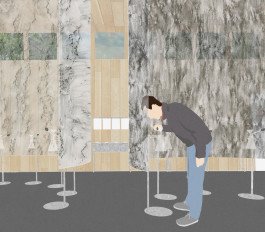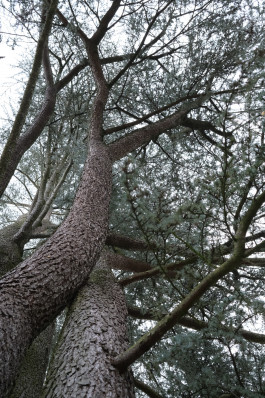“Wald im Wandel” (Changing Forest)

“Wald im Wandel” (Changing Forest) is an interactive exhibition concept for the context of environmental education that explains the effects of the forestry method of "assisted migration" on the near-natural habitat forest and makes it tangible. In this approach, tree species from warmer and drier regions are introduced into native forests in small percentages on clear-cut areas in order to prepare the forest for climate change.
For Rhineland-Palatinate, 16 species tested for suitability were recommended by Landesforsten. At the centre of the concept are sensory rooms that allow visitors to experience the complementary tree species through scent exhibits. Trees communicate with each other by using so-called VOC's, volatile chemical compounds, which can be perceived by humans as scents. This type of communication is transferred into the exhibit, so that visitors can get to know the trees through "their" communication channels.


For many people, the consequences of climate change still lie in the distant future. For some, they are already part of their daily work. Especially intergenerational ways of working like forestry have to think about possible and actual consequences of climate change already now.
The aim of the master thesis was the development and design of an interactive exhibit or exhibition concept for the transfer of knowledge in the subject area of consequences of climate change management and climate change impact management in the near-natural habitat forest. By singling out a specific practice of forestry/science, it is shown how climate management methods are used in a near-natural habitat that is used by people in many ways. These methods have a direct impact on the future perception of "forest".

The introduction of the complementary species takes place in the real laboratory "forest". I translated the laboratory character into the design of the scent exhibits, which are made tangible with laboratory glasses and medical aids. Interactive exhibits are often equipped with a lot of electronic technology, which often triggers inhibitions. To counteract this, the concept uses mechanical ball pumps, which at first glance made it clear how the exhibit works.
The premises offer a large exhibition space with many windows, which provide a view of the Palatinate Forest. To facilitate the olfactory perception of the scents and to facilitate concentration, the scent exhibits, divided into deciduous and coniferous trees, are located in semi-transparent cylindrical room-in-room installations. These are covered with frottages of the respective tree species. The printed, lightly waving fabric panels divide the space without separating the exhibits too much from it.
Process

Since climate changes will differ from region to region, it was obvious from the beginning to limit the conception of the work to one region. Due to its southern location, Rhineland-Palatinate will be more affected by climate change than other German states, and it is also the state (along with Hesse) with the most forests.
The focus of the work was to get to know the complementary tree species. Trees, plants and other species can communicate with each other via gases. Especially under stress, trees release a lot of so-called VOCs (volatile organic compounds), which we humans can perceive as a scent. Other trees are thus warned of enemies, among other things, and possible useful insects are attracted. We can therefore perceive plant scents, but cannot decipher their "codes". Trees are individuals and complexly embedded in ecosystems. The human-object interaction is to be seen here primarily as barrier removal, but also as an artistic-creative approach to the practice of assisted migration, or the active intervention of humans in the near-natural habitat of the forest. Fleeting encounters are created with tree species that could become part of the near-natural forest habitat in the future.



